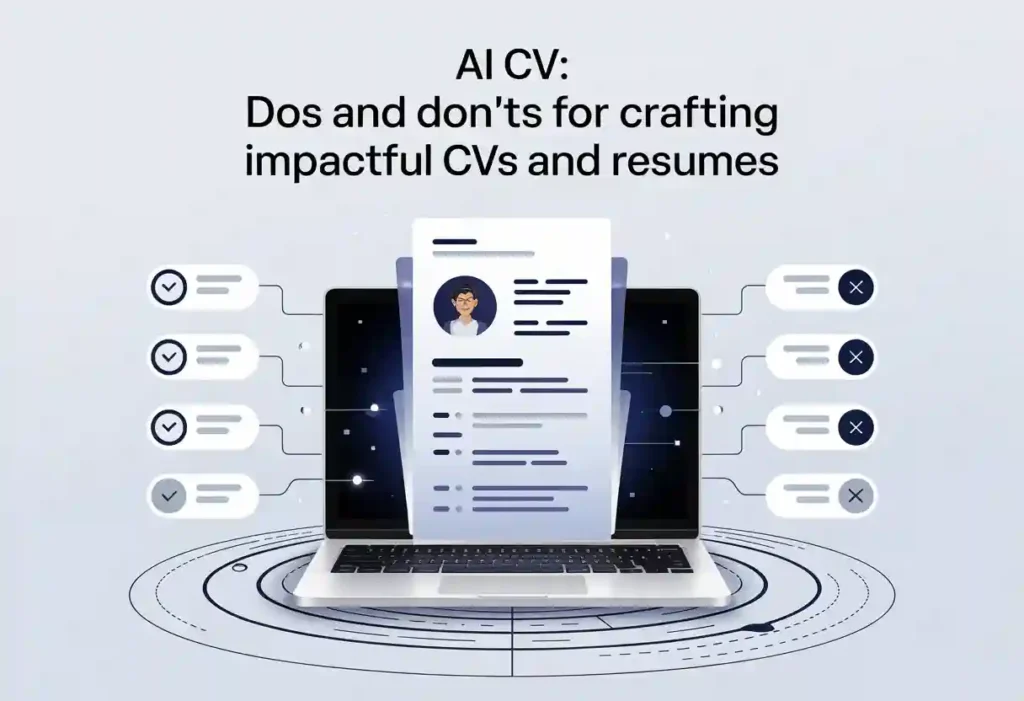The Power of Defining and Steering Your Career Path
Close your eyes for a minute and imagine your dream job.
What is it? How does your first day feel? Now imagine the things you have to do to get there. What new skills, qualifications, and experience must you acquire to achieve your career goals?
Your answer is your career path.
Whether you are ten years into the job market or just got your college degree, you must set a career path.
Failing to define your professional future actively leaves you open to interference, lost time, and wasted talent.
Without a clear career path, you don’t have a reason to learn new skills and take on new projects.
This means you only do the things your employers want you to do. It also means you have little to no say over your career growth or whether it happens at all.
You can take back control by choosing and refining your career path.
You don’t need to figure everything out: career paths often change. You do, however, need a concrete strategy for the things you must do to climb the career ladder.

What Is Your Career Path and Why Is It Important?
Think of your career path as stepping stones across a pond. The first stepping stone represents the first career-oriented job you held. Every stone after that means the next role that came in your career.
Ideally, this walkway should have a destination: your dream job. Yet, the whole journey represents what we mean by a career path.
However, career paths are not often a linear progression of roles, each progressing nicely toward a given end. Life usually gets in the way. Sometimes you must take a job that is lateral or tangential to your plan.
You might even have to go back to education to go forward again.
All sorts of things happen that can influence the route to your dream job.
Thus, people’s stepping stones are often much more nuanced than a straight line.
The industry you have chosen to enter usually influences your career path heavily.
Nonetheless, thinking about your career path is often essential for several reasons:
- It means you don’t waste time in a role without value in reaching your goal.
- You stay in a progressive mindset, always working to advance in your professional development.
- You engage in what is important to you in your career, and which jobs can provide these things. These values include financial incentives, flexibility, charity, or responsibility.
Tips
As good as it is to have a firm idea of your professional trajectory, try to remain open to opportunities that come your way.
Why? Other opportunities may provide new experiences and skills you didn’t know you needed.
How Can You Take Control of Your Career Path?
Below are some critical ideas on taking control of your career. We mean proven ideas for ensuring you are constantly progressing towards your goal of that ideal role.
- Be proactive ─ As discussed, don’t let your career path happen to you; be in the driver’s seat. Assess where you are and where you’re going. Take an active role in the next step at every point in your career. One step at a time.
- Set short and long-term goals ─ What do you want from your current position? Where do you want to be in 5 years? What are some critical landmarks you can check off towards your next role?
- Remain flexible – Things don’t always go according to plan; this is part of the process. Don’t lose confidence if parts of your journey aren’t exactly how you envisioned them. This will keep your motivation high and ensure you have the ‘get up and go’ to move to the next stage of your plan.
- Get help—Everyone from Barack Obama to Lewis Hamilton had help getting to where they are. Know how to recognize and accept assistance and advice from those in your best interests. A strong support network gives you that safety net to try bigger and better things.
- Have a plan—even if it’s as simple as a few roles you hope to have under your belt by age 30. Give yourself a structure to understand and evaluate your career progress year after year.
Career Path Examples (For Select High-Demand Jobs)
Here are 16 career paths for high-demand jobs based on trends:
Software Development:
Software Developer Intern → Junior Software Developer → Software Developer → Senior Software Developer → Lead Software Developer → Software Architect → Director of Engineering → VP of Engineering
Data Science & Machine Learning:
Data Analyst Intern → Junior Data Analyst → Data Analyst → Senior Data Analyst → Data Scientist → Senior Data Scientist → Lead Data Scientist → Director of Data Science → VP of Data → Machine Learning Engineer → Head of Data Science → Chief Data Officer
Renewable Energy & Sustainability:
Sustainability Intern → Junior Sustainability Coordinator → Sustainability Specialist → Renewable Energy Engineer → Senior Renewable Energy Engineer → Sustainability Manager → Director of Sustainability → VP of Sustainability → Chief Sustainability Officer
Cybersecurity:
Cybersecurity Analyst → Cybersecurity Engineer → Senior Cybersecurity Engineer → Cybersecurity Architect → Director of Cybersecurity → Chief Information Security Officer
Cloud Computing:
Cloud Engineer → Senior Cloud Engineer → Cloud Architect → Principal Cloud Architect → Director of Cloud Engineering → VP of Cloud Services → Chief Technology Officer
Healthcare:
Certified Nursing Assistant (CNA) → Licensed Practical Nurse (LPN) → Registered Nurse (RN) → Nurse Practitioner (NP) → Nursing Manager → Director of Nursing → Chief Nursing Officer
Finance:
Financial Analyst → Senior Financial Analyst → Finance Manager → VP of Finance → Chief Financial Officer
E-commerce & Digital Marketing:
Digital Marketing Intern → Junior Digital Marketer → Digital Marketing Specialist → E-commerce Manager → Senior E-commerce Manager → Director of E-commerce → Digital Marketing Director → Chief Marketing Officer (CMO)
Physical Therapist:
Physical Therapist Aide → Physical Therapist Assistant → Physical Therapist → Senior Physical Therapist → Physical Therapy Clinic Director
Information Security Analyst:
Information Security Associate → Information Security Analyst → Senior Information Security Analyst → Information Security Manager → Chief Information Security Officer
Nurse Practitioner:
Registered Nurse → Family Nurse Practitioner → Senior Nurse Practitioner → Nursing Practice Manager → Director of Nursing
Market Research Analyst:
Market Research Assistant → Associate Market Research Analyst → Market Research Analyst → Senior Market Research Analyst → Market Research Manager
Construction Manager:
Assistant Construction Manager → Construction Manager → Senior Construction Manager → Director of Construction → Vice President of Construction
Medical and Health Services Manager:
Assistant Health Services Manager → Health Services Manager → Senior Health Services Manager → Director of Healthcare Services → VP of Operations
Software Quality Assurance Engineer:
Associate QA Engineer → QA Engineer → Senior QA Engineer → QA Lead → Director of QA
Wind Turbine Technician:
Wind Turbine Technician Trainee → Wind Turbine Technician → Lead Wind Turbine Technician → Wind Turbine Maintenance Supervisor → Wind Turbine Operations Manager
N/B: We have classified these paths into traditional jobs and anticipated growth in specific sectors. Each career path can vary based on the individual, company, or industry specifics. The titles mentioned may have different responsibilities in various organizations

Self-Assessment and Goal Setting: Setting Down Your Career Path
Any good plan starts with analysis. And so does a good career path.
The first step to picking ideal fields or roles is self-assessment. You must ask guided questions about your interests, passions, and talents.
This active reflection will enable you to narrow down your plans and make more specific choices.
Some questions you can ask yourself include:
- What are my critical interests?
- What are my core values?
- What personal or professional activities am I most passionate about?
- What are my strengths, best skills, and weaknesses?
- What do I want to achieve in my career?
- Do I want to take on an upper management or consulting role later?
Setting Short and Long-Term Goals for Accelerated Progression
Once you narrow down your choices, you can establish a career plan with milestones and deadlines.
Study examples of career paths in your field and what other people in your industry or specific job achieve at 5 years, 10 years, and so on.
Determine which example accomplishments align with your career and write them down.
This includes specific job titles, projects, skills, and more. Next, determine what you must do to achieve these goals.
Do you need to return to school, enroll in a training program, take on more job responsibilities, or find a mentor? Use the SMART technique to set specific, manageable, actionable, realistic, and time-bound goals.

Dealing with Setbacks [Turning Challenges into Opportunities]
Things will not always go according to plan, and you will likely experience setbacks as you try to climb your career ladder.
Instead of letting any challenging experience deter you from your path, you can turn them into opportunities.
Some things to do include:
- Acknowledge the situation
- Revise your career path goals
- Determine where you went wrong
- Take steps to fix your mistake
- If you missed out on an employment opportunity, reach out to hiring managers to find out why you didn’t get hired
- Ask for advice from your mentor on career pathing.
- Improve your skills to boost your career portfolio, employability, decision-making, and leadership abilities.
- Get back on the right career path.
Continuous Learning: The Engine of Your Career Path Progress
There is no better way to grow your career than to keep learning. The employment market is constantly changing, and the tools you need to remain competitive with it are constantly changing.
Continuing your education can equip you with the skills, knowledge, and experience to adapt to industry trends and an ever-changing professional landscape.
It could also open more earning opportunities later. According to the Bureau of Labor Statistics data on job searches, professionals with a bachelor’s degree earn, on average, $525 a week more than people with a high school diploma.
This gap gets more expansive as the level of education increases. For instance, someone with a master’s degree will likely get paid more than recent college students.

Upskilling: A Crucial Element for Staying Competitive in the Market
In the simplest terms, upskilling is enhancing your current knowledge and skills. When you upskill, you learn new technologies and concepts that help you maintain your viability within your industry.
Upskilling is vital because it gives you a competitive advantage, including over people with more experience than you. It is also the most effective way to future-proof your position.
Strategies for Continuous Learning to Enhance Your Skill Set
If you are already in the employment market, the most convenient way to boost your skillset is through part-time training programs, courses, and seminars.
You can take diploma courses to learn new insights and gain certification. These certifications can increase your suitability for higher roles and salaries.
Soft Skills: The Unspoken Secret of Career Success
And as you learn, pay special attention to soft skills.
Soft skills combine your personality traits, emotional intelligence, communication skills, social skills, and other attributes that allow you to work well with others.
While they can be taught, soft skills are not as curriculum-based as hard skills. Think about it: No one has to introduce you to be flexible, respectful, and make small talk.

The Impact of Communication, Leadership, and Teamwork on Excelling in Your Career
If hard skills help you land a job, soft skills help you keep it and grow within your field.
You need three critical soft skills for a successful career: communication, leadership, and teamwork.
Communication is how you respond to people and share your ideas. As your career advances, you will find that you need to communicate with more than just your colleagues.
You may have to talk to company executives, job seekers, clients, potential investors, and vendors. Mastering communication clearly and professionally will help you foster positive relationships with these people.
It will also help you get your ideas across faster and more effectively.
Essential skills include adapting your discussion to your audience, reading, and writing. Other examples include understanding body language and communicating electronically, such as through email.
As you hone these skills, you may find yourself in more leadership roles. As a leader, you need strong problem-solving, conflict resolution, and supervisory skills.
These strengths can help you advance your career path faster. You must also be able to work within a team.
Your teammates are likelier to refer you to new openings if they enjoy working with you.

Developing Problem-Solving and Adaptability Skills for Becoming an Asset in Any Work Environment
Today’s job market also requires you to be adaptable and a problem solver.
Your ability to adapt to change and even turn curveballs into opportunities will help you remain viable and competitive in different career paths.
Your employers will value you more if you immediately jump into action instead of complaining and develop actionable solutions to problems.

Nurturing Professional Relationships
You will connect with other people within and outside your field during your career. This is called your professional network and is crucial to your career portfolio.
You must maintain contact with these people, who could expose you to your dream job.
They could also offer real-life examples of career paths.
How to Use Networking as a Powerful Tool for Unlocking Career Opportunities
Jobvite reports that 3 in every 10 job seekers discover job listings through their professional networks. Connecting with former employees and other professionals can expose you to new opportunities in new career paths. It can also help you grow in your current role.
To use this powerful resource, you can create your network. Do this by:
- Asking your coworkers, including those from different departments, to coffee or lunch. Use this chance to learn more about them and their diverse career paths. Find out how you can help each other grow your careers.
- Reach out to your LinkedIn contacts and do informational interviews. You can also catch up on recent news in their companies or fields.
- Attending industry workshops and conferences to meet new people.
- Joining industry-related groups, social clubs, and online message boards to connect with like-minded professionals and discuss industry trends.
- Attending industry conferences.
Career Coaching: Your Guide to Navigating Your Career Path
Consulting those who have done it before makes sense if the plan is to walk a career or business path.
Learning from professionals who have achieved what you want to, or career coaching, can help you advance faster.
This is because it can eliminate the trial-and-error phase of your journey and allow you to focus on proven tactics for professional growth.
The Advantage of Professional Career Advice in Achieving Your Career Aspirations
Usually, your career coach or mentor will be someone in the same industry as you. Working with them can open you to new opportunities and ideas you might not have thought of.
Mentors are also external forces. This means they can push you to try new hobbies, explore your creativity, and seek advancement, even when you do not like it.
How to Get Started with Career Coaching and Fast-Track Your Career Goals
As with networking, the best way to find mentors is to start where you are.
Ask your boss or team manager if they can mentor you. Because of their advanced roles and familiarity with your work, supervisors can help you tap into your natural talents.
They are also around you all day, which allows them to monitor your progress more regularly.
Ask your manager for recommendations, hire a professional career coach, or leverage your network.

Work-Life Balance: A Must for Fulfilling Career Paths
Of course, all of this can be stressful. Upskilling, networking, and career coaching can interfere with your personal life, leaving you exhausted and burnt out.
You may eventually become so exhausted that you cannot attend to your career.
This is why a healthy work-life balance is a must-have tool for career development.
Balancing Work and Life to Enhance Productivity and Wellbeing
A work-life balance allows enough time for productivity at work and a healthy personal life. This means that your relationships, social life, and hobbies do not suffer due to your work.
A good work-life balance ensures you are happy and productive in all areas of your life.
It helps you manage your time correctly so you have enough time and energy to explore your career path.
When you work for an unhealthy amount of time, your work can become unsafe, increasing your stress levels.
You can prevent this by prioritizing and taking the following steps:
- Define Your Values. Take time to think about the things that are most important to you. In addition to your career, consider your interests, passion, family, health, and social life.
- Appoint a Time for Key Activities. Once you establish your priorities, divide your days or weeks into dedicated time slots for different activities.
- Set Boundaries. Blowing off Sunday lunch with your mum to finish a project is easy, but this will lead to exhaustion. Set limits and always honor pre-planned schedules.
- Go Offline. Set aside some time every day to mute your notifications and relax.
- Prioritize Your Health. Spare time for healthy meals, sleep, and exercise. This will give you enough energy to tackle your work responsibilities while maintaining your health.
- Nurture Your Relationships. Spend quality time with your friends, family, and loved ones. Their support can be crucial to helping you pursue career advancement.
Stress Management Techniques for Preventing Burnout for Long-Term Career Success
A 2011 report showed that 8 in every 10 workers across different job titles, industries, and careers reported being stressed.
Stress is the most common outcome of an unhealthy work-life balance. Left unchecked, it can significantly lower your productivity and endanger your mental and physical health.
Some techniques to help you manage stress and concentrate on your career growth include:
- Adopt stress relief activities like yoga, meditation, mindfulness, and deep breathing.
- Slow down and de-stress daily by doing something physical outside, like swimming or walking.
- Trace and monitor your stressors and avoid stressful situations.
- When stressed at work, take a step back and try to look at the situation in a positive light before responding.
- Go offline regularly.
- Work with your employer to make your workspace less stressful. This may include transferring to a new team or getting a more comfortable desk. It can even be working out more flexible hours.
Considering a Career Switch to Open New Doors in Your Career Path
Sometimes, however, even the best strategy might not be enough to get you to your career goals.
This is especially true if your current career path offers few opportunities for advancement. Or if your interests have changed.
In this case, consider a career change. You can shadow your colleagues from different departments within your company to explore other options. You can also examine fields similar to yours.
But only consider this option if:
- You are always tired or bored at work
- Your mentor agrees that a career change might be good for you
- Your job is stressing you to the point of affecting your self-esteem
- Your field offers no chances for professional development
Like this post?
Sign up for our blog updates and never miss a post.
We’ll send you A FREE job interview eBook as a thank-you.
Notable Takeaways
Hopefully, having read this blog, you will now understand a career path. You have learned why it is crucial to your success in finding your ideal job.
Some key points to remember are:
- Think about what you want from your career and what is important to you in a role. Why? So that you can get an idea of where you want to focus your efforts.
- Use your network to find prospects and get advice when seeking a new position. Knowing how to ask for help is one of the most critical skills. It will help tremendously when deciding on and implementing your career plan.
- Acquire and maintain a progressive mindset. Consider what is next and evaluate where you are often so that you can move forward frequently.
- Be resilient; professional life isn’t always smooth sailing. Organizations collapse, roles fall through, and people let you down. Learning from setbacks and not letting them get you down is essential.
Charting a Path to a Happier, More Successful Tomorrow
As with everything else in your life, the growth of your career lies in your hands.
The job market changes daily, requiring the workforce to change to remain viable. Successful employees often have to upskill, network, and revisit their goals to stay on track.
This applies to you, too.
As you chart your path to your desired career, practice setting SMART goals, overcoming roadblocks, and continually improving yourself.
Take as many courses as your schedule allows, learning hard skills relevant to your field and soft skills like leadership and communication that will increase your competitive advantage.
And, above all, remember to maintain a healthy work-life balance.
Take care of yourself, allow yourself room to make mistakes, and ask for help whenever necessary.
You should soon be on your way to the life of your dreams.
Next Time…
Part two of this blog series will explore the mechanics of creating a career path plan. The one that takes you from graduating from university or college to your dream job.
In addition, we will discuss more examples of career paths for a range of different industries.
This will provide inspiration and a rough framework for several careers and how to reach those top spots.
Meanwhile, we created a must-read article on how to write a resume like a professional resume writer would. Click the link to get started.
Until then, read some of our other great content on how to find the best career for yourself here:
Further Reading
- How To Become More Employable Straight Out Of University
- Should You Send The Same Resume For Different Jobs?
- Employability Training at NECareersConnect




